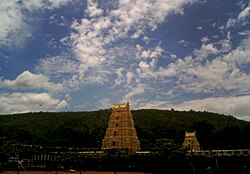Mahanandi (Telugu: మహానంది) is a village located east of the Nallamala Hills near Nandyal, Kurnool District, Andhra Pradesh, India. It is a picturesque village surrounded by thick forests. Within 15 km of Mahanandi, there are nine Nandi shrines known as Nava nandulu.
Mahanandi is one of the Nava Nandis. The Mahanandiswara Swamy Temple,
an important shrine, is located here. This ancient temple dates back
over 1,500 years. The inscriptions of 10th century tablets speak of the
temple being repaired and rebuilt several times.
These nine temples are Mahanandi, Shivanandi, Vinayakanandi, Somanandi, Prathamanandi, Garudanandi, Suryanandi, Krishnanandi (also called Vishnunandi) and Naganandi.
A festival is held here annually during February and March to celebrate Maha Shivaratri, the Great Night of Shiva.
Mahanandi is about 21 km from Nandyal. The nearest airport is at Hyderabad, which is about 215 km from Kurnool, and the nearest railway station is at Nandyal. There are 2 routes to reach Mahanandi from Nandyal town. One route via Thimmapuram and is the shortest, around 17 km from bus stand. Another route, via giddalur road you need to take left diversion at Boyalakuntla cross and it will be around 24 km distance from nandyal.
The main temple is surrounded by three pools: two small pools at the entrance and one big pool inside the temple itself. This holy tank is 60 square feet (5.6 m2) with an outdoor pavilion called a mandapa in the centre. The inlets and outlets of the tank are arranged so that the depth of the water is constantly kept at five feet, thus enabling pilgrims to bathe in the holy waters. Bathing in the inside big pool is prohibited after 5 PM every day.
A peculiarity of the water source is that it has a constant flow irrespective of the change of seasons. The water source originates at the Garbhagruha (inner shrine) just below Swayambhu Linga. One can touch the water near the Shiva Linga (symbol of Shiva). The devotees can offer prayers and touch the Shiva Linga. This is unusual, because traditionally at temples, the main deity is kept away from the touch of the devotees.
The water is famous for its crystalline and healing qualities and is ever tepid. The outgoing water irrigates 2,000 acres (8.1 km2) of fertile land surrounding the village. The surrounding areas are under production with rice fields, fruit, vegetable and flower gardens.The temple is well known for the konneru. The water during the winter season will be very hot and vice versa during the summer. During the early mornings, you can feel the water luke warm and water gets cooled gradually with the rise in temperature

Mahanandi
మహానంది

Worlds biggest Nandi statue at Mahanandi
These nine temples are Mahanandi, Shivanandi, Vinayakanandi, Somanandi, Prathamanandi, Garudanandi, Suryanandi, Krishnanandi (also called Vishnunandi) and Naganandi.
A festival is held here annually during February and March to celebrate Maha Shivaratri, the Great Night of Shiva.
Mahanandi is about 21 km from Nandyal. The nearest airport is at Hyderabad, which is about 215 km from Kurnool, and the nearest railway station is at Nandyal. There are 2 routes to reach Mahanandi from Nandyal town. One route via Thimmapuram and is the shortest, around 17 km from bus stand. Another route, via giddalur road you need to take left diversion at Boyalakuntla cross and it will be around 24 km distance from nandyal.
Temple pools
The temple is famous for its fresh water pools, called Kalyani or Pushkarni. The architecture of the pools and temple shows the skill of the Vishwakarma Brahmins.The main temple is surrounded by three pools: two small pools at the entrance and one big pool inside the temple itself. This holy tank is 60 square feet (5.6 m2) with an outdoor pavilion called a mandapa in the centre. The inlets and outlets of the tank are arranged so that the depth of the water is constantly kept at five feet, thus enabling pilgrims to bathe in the holy waters. Bathing in the inside big pool is prohibited after 5 PM every day.
A peculiarity of the water source is that it has a constant flow irrespective of the change of seasons. The water source originates at the Garbhagruha (inner shrine) just below Swayambhu Linga. One can touch the water near the Shiva Linga (symbol of Shiva). The devotees can offer prayers and touch the Shiva Linga. This is unusual, because traditionally at temples, the main deity is kept away from the touch of the devotees.
The water is famous for its crystalline and healing qualities and is ever tepid. The outgoing water irrigates 2,000 acres (8.1 km2) of fertile land surrounding the village. The surrounding areas are under production with rice fields, fruit, vegetable and flower gardens.The temple is well known for the konneru. The water during the winter season will be very hot and vice versa during the summer. During the early mornings, you can feel the water luke warm and water gets cooled gradually with the rise in temperature

Mahanandi
మహానంది

Worlds biggest Nandi statue at Mahanandi
